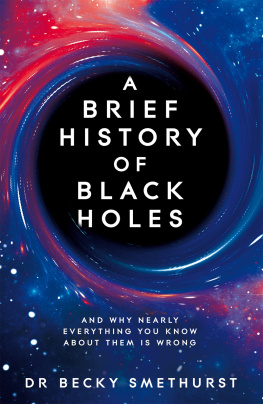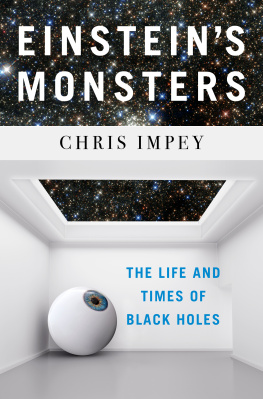Steven S. Gubser - The Little Book of Black Holes
Here you can read online Steven S. Gubser - The Little Book of Black Holes full text of the book (entire story) in english for free. Download pdf and epub, get meaning, cover and reviews about this ebook. year: 2017, publisher: Princeton University Press, genre: Art. Description of the work, (preface) as well as reviews are available. Best literature library LitArk.com created for fans of good reading and offers a wide selection of genres:
Romance novel
Science fiction
Adventure
Detective
Science
History
Home and family
Prose
Art
Politics
Computer
Non-fiction
Religion
Business
Children
Humor
Choose a favorite category and find really read worthwhile books. Enjoy immersion in the world of imagination, feel the emotions of the characters or learn something new for yourself, make an fascinating discovery.
- Book:The Little Book of Black Holes
- Author:
- Publisher:Princeton University Press
- Genre:
- Year:2017
- Rating:4 / 5
- Favourites:Add to favourites
- Your mark:
- 80
- 1
- 2
- 3
- 4
- 5
The Little Book of Black Holes: summary, description and annotation
We offer to read an annotation, description, summary or preface (depends on what the author of the book "The Little Book of Black Holes" wrote himself). If you haven't found the necessary information about the book — write in the comments, we will try to find it.
The Little Book of Black Holes — read online for free the complete book (whole text) full work
Below is the text of the book, divided by pages. System saving the place of the last page read, allows you to conveniently read the book "The Little Book of Black Holes" online for free, without having to search again every time where you left off. Put a bookmark, and you can go to the page where you finished reading at any time.
Font size:
Interval:
Bookmark:
THE LITTLE BOOK OF BLACK HOLES
Books in the SCIENCE ESSENTIALS series bring cutting-edge science to a
general audience. The series provides the foundation for a better understanding
of the scientific and technical advances changing our world. In each volume, a
prominent scientistchosen by an advisory board of National Academy of Science
membersconveys in clear prose the fundamental knowledge underlying a rapidly
evolving field of scientific endeavor.
The Great Brain Debate: Nature or Nurture,
BY J OHN D OWLING
Memory: The Key to Consciousness,
BY R ICHARD F. T HOMPSON AND S TEPHEN M ADIGAN
The Faces of Terrorism: Social and Psychological Dimensions,
BY N EIL J. S MELSER
The Mystery of the Missing Antimatter,
BY H ELEN R. Q UINN AND Y OSSI N IR
The Long Thaw: How Humans Are Changing the Next 100,000 Years of Earths Climate,
BY D AVID A RCHER
The Medea Hypothesis: Is Life on Earth Ultimately Self-Destructive?
BY P ETER W ARD
How to Find a Habitable Planet,
BY J AMES K ASTING
The Little Book of String Theory,
BY S TEVEN S. G UBSER
Enhancing Evolution: The Ethical Case for Making Better People,
BY J OHN H ARRIS
Natures Compass: The Mystery of Animal Navigation,
BY J AMES L. G OULD AND C AROL G RANT G OULD
Heart of Darkness: Unraveling the Mysteries of the Invisible Universe,
BY J EREMIAH P. O STRIKER AND S IMON M ITTON
Oxygen: A Four Billion Year History,
BY D ONALD C. C ANFIELD
The Cosmic Cocktail: Three Parts Dark Matter,
BY K ATHERINE F REESE
Lifes Engines: How Microbes Made Earth Habitable,
BY P AUL G. F ALKOWSKI
The Little Book of Black Holes,
BY S TEVEN S. G UBSER AND F RANS P RETORIUS
the
LITTLE BOOK
of
BLACK HOLES

S TEVEN S. G UBSER
& F RANS P RETORIUS
PRINCETON UNIVERSITY PRESS PRINCETON AND OXFORD
Copyright 2017 by Steven S. Gubser and Frans Pretorius
Requests for permission to reproduce material from this work
should be sent to Permissions, Princeton University Press
Published by Princeton University Press,
41 William Street, Princeton, New Jersey 08540
In the United Kingdom: Princeton University Press,
6 Oxford Street, Woodstock, Oxfordshire OX20 1TR
press.princeton.edu
Cover art and design by Jess Massabrook
All Rights Reserved
Library of Congress Cataloging-in-Publication Data
Names: Gubser, Steven Scott, 1972 author. | Pretorius, Frans, 1973 author.
Title: The little book of black holes / Steven S. Gubser
and Frans Pretorius.
Description: Princeton, New Jersey ; Oxford :
Princeton University Press, [2017]
Identifiers: LCCN 2017024783| ISBN 9780691163727 (hardback ;
alk. paper) | ISBN 0691163723 (hardback ; alk. paper)
Subjects: LCSH: Black holes (Astronomy)
Classification: LCC QB843.B55 G83 2017 | DDC 523.8/875dc23
LC record available at https://lccn.loc.gov/2017024783
British Library Cataloging-in-Publication Data is available
This book has been composed in Bembo Std
Printed on acid-free paper.
Printed in the United States of America
1 3 5 7 9 10 8 6 4 2
CONTENTS
PREFACE
I T WAS S EPTEMBER 14, 2015, ALMOST EXACTLY 100 YEARS after Albert Einstein formulated the General Theory of Relativity. Two massive detectors, one in Louisiana and one in Washington, were undergoing final preparations for a science run aimed at detecting gravitational waves. Suddenly and unexpectedly, the detectors instrumentation recorded a peculiar chirp. If we made this chirp audible, it would sound like a faint, low-pitched thump.
Five months later, after careful scrutiny of the data recorded by these detectors, the Laser Interferometer Gravitational Wave Observatory (LIGO) publicly announced their results. That chirp was exactly the sort of signal they had hoped to detect. It was the distant echo of a pair of black holes caught in the act of merging into a single, larger black hole. The physics community was electrified. It was as if we had lived for all our lives blind to the color red, and at the moment the veil was lifted we saw a rose for the first time.
And what a rose it was! Best estimates from LIGO indicated that the faint thump they recorded was the result of the coalescence more than a billion years ago of two black holes, each of them roughly thirty times the mass of the Sun. During the collision, some three solar masses worth of energy from the black holes was vaporized into gravitational radiation.
Black holes and gravitational waves are both consequences of Einsteins general theory of relativity. General relativity predicts what sort of gravitational waves the LIGO detector should see in the event of a black hole collision, and the chirp recorded on September 14 was beautifully close to expectations. Not only is it a vindication of long-cherished theoretical ideas; this first detection event also augurs a new era of gravitational wave astronomy. The LIGO detectors saw one event of the sort weve dreamed of for decades. Now we want to explore a whole new garden of gravitational surprises.
Science seldom involves mathematical certainties, so we should ask, how sure are we that LIGO construed correctly that the little chirp is the distant echo of a billion-year-old black hole merger? Briefly, the answer is, Pretty sure. Everything seems to fit. The signal was seen by both detectors. Nothing else seemed to be happening nearby that would explain the signal. The signal was strong enough to see with the current device, but too weak to be observed by earlier technology. The hypothesis of a black hole merger a billion years ago doesnt conflict with our general understanding of astrophysics and cosmology. The key point is that we have good hopes of seeing more such events. Indeed, LIGO announced a second confirmed event that occurred on Christmas day 2015, and a third that occurred on January 4, 2017. These events are broadly comparable to the first discovery and should give us significantly more confidence that LIGO is truly observing black hole mergers. Altogether, we believe that we are standing at the dawn of a new age in observational astrophysicsone in which black holes will play a pivotal role.
In this book, we describe black holes, both as astrophysical objects whose existence is now almost beyond . Then in subsequent chapters, we go on to discuss Schwarzschild black holes, rotating black holes, collisions of black holes, gravitational radiation, Hawking radiation, and information loss.
So, just what is a black hole? Essentially, it is a region of spacetime toward which matter is drawn and from which escape is impossible. Lets focus the discussion on the simplest black holes, known as Schwarzschild black holes (in honor of their discoverer, Karl Schwarzschild). Theres an old saying, What goes up must come down. Inside a Schwarzschild black hole, a stronger statement is true: Nothing can go up. Only down. But we are not sure where down eventually leads. The most straightforward hypothesis, given the mathematics behind Schwarzschild black holes, is that a terrible, infinitely compressed kernel of matter lurks at its core. Colliding with that core is the end of everything. It is even the end of time. This hypothesis is hard to test because no observer who goes into a black hole can ever report back on what he sees.
Before we go on to explore Schwarzschild black holes in more depth, lets first take a step back and consider gravity in some of its milder forms. From the surface of the Earth, if we impart a sufficiently large upward velocity to an object, then it will keep moving upward forever. The minimal velocity for which this is true is the escape velocity. Neglecting air friction, escape velocity is approximately 11.2 kilometers per second. By way of comparison, its hard for a human to throw a ball faster than about 45 meters per secondless than half a percent of escape velocity. The muzzle velocity of a high-powered rifle is roughly 1.2 kilometers per secondso, slightly more than 10% of escape velocity. What we usually mean, then, by What comes up must come down is that Earths gravity is strong compared with how forcefully we can propel objects upward using ordinary means.
Next pageFont size:
Interval:
Bookmark:
Similar books «The Little Book of Black Holes»
Look at similar books to The Little Book of Black Holes. We have selected literature similar in name and meaning in the hope of providing readers with more options to find new, interesting, not yet read works.
Discussion, reviews of the book The Little Book of Black Holes and just readers' own opinions. Leave your comments, write what you think about the work, its meaning or the main characters. Specify what exactly you liked and what you didn't like, and why you think so.













